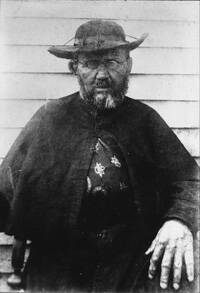Find Your Molokai
The church has a new saint. On Oct. 11, Pope Benedict XVI canonized Damien of Molokai. The Belgian-born Joseph de Veuster (he took the religious name Damien after joining the Congregation of the Sacred Hearts of Jesus and Mary) was missioned to the Hawaiian Islands in 1864 and a few years later began his work among people suffering from Hansen’s disease (then called leprosy), who were banished to the island of Molokai to limit contagion. The priest spent the rest of his life ministering to the sick until he too contracted the disease. He died in 1889 at the age of 49.
It is a stirring story. But what can the almost impossibly heroic life of St. Damien of Molokai say to everyday believers? Like that of many saints, Damien’s life may seem undeniably noble, but difficult to emulate in our own workaday lives. Still, powerful resonances can be heard if we listen carefully. What parent is not called upon to minister to a child who falls ill, even at the risk of contracting the same illness? Who is not called to stand with the outcast, with those whom polite society shuns either literally or metaphorically? Who is not called to do works of charity and love that remain hidden from the rest of the world? Damien’s Molokai is not so far away as many might think.
When the faithful used to visit Mother Teresa and ask to work alongside her, she would often say, “Find your own Calcutta”—that is, care for the poor and forgotten where you are. Perhaps the story of St. Damien says to us, “Find your own Molokai.”
The Vanishing Koala
One of Australia’s most endearing signature animals, the koala, is in danger of dying out unless the government takes action. The koalas (which are mammals but not bears) depend on eucalyptus leaves for both food and water. Primarily nocturnal, they eat between one and two pounds of leaves each night. As urbanization spreads, however, more people are moving into the koalas’ traditional habitat areas and more and more eucalyptus trees are being cut down.
The attendant stress among the koalas is bringing out a latent viral disease that results in infections of the eyes and urinary, reproductive and respiratory tracts that leads to blindness, infertility and death. The disease now infects from 50 percent to 90 percent of the animals. While some koalas are killed by dogs and car accidents, the virus accounts for 60 percent of koala deaths.
When the Europeans settled the continent in the late 1700s, there were millions of koalas. The Australian Koala Foundation estimates that fewer than 100,000 koalas are now left in the country. Many of them are now clustered along the so-called Koala Coast, a 155-square-mile swath of land in the southeastern part of Queensland. The chief executive of the foundation, Deborah Tabart, has urged the government to classify the koala as a threatened species. It is not the only one in Australia. Over 55 Australian mammal, bird and reptile species have become extinct. The koala’s current life-threatening plight underscores the fragility of wildlife not only in Australia but throughout the world as the human footprint becomes heavier and heavier.
A Pastoral Choice
More resources should be put into the availability of retroviral drugs than into the production and distribution of condoms, according to Cardinal Peter Kodwo Appiah Turkson, archbishop of Cape Coast, Ghana, and relator-general of the Second Special Assembly for Africa of the Synod of Bishops. The relator-general, or recording secretary, one of the four papal-appointed key officials of the synod, explained this in a press conference in Rome.
Cardinal Turkson addressed the subject of Catholic teaching on the sensitive topic of ministering to a married couple when one of the two is infected with H.I.V. He said that the priority for African bishops in teaching such couples remains “abstinence, loyalty and fidelity” within marriage. Yet he preferred a pastoral way of ministering to them. The pastor does not decide what the couple must do but rather exposes and opens the issues and allows the person or couple to make their own decision.
This would leave open the possibility that couples might choose to use a condom to prevent spreading AIDS to their spouse, a view seldom expressed by church leaders in Africa. The cardinal said he would make sure that couples understand that any use of condoms is risky, since condoms are not always reliable and give users a false sense of security.
In broaching the subject in this way, Cardinal Turkson has shown a style of pastoral leadership that values information and persuasion, respect for the consciences of Catholics in Africa, and an awareness that overcoming the AIDS pandemic requires not only prevention but also medicine.








